Spongy moth
EXOTIC PEST - Not wanted in Australia
Spongy moth (Lymantria dispar)is a highly invasive pest with a vast host range and poses a serious threat to agricultural, horticultural, forestry and nursery industries.
Keeping Spongy moth out of the country is a national priority.
Have you seen this pest?
- Female moths are up to 63 mm long. They have cream-coloured wings with black markings . Males are smaller, mottled brown to grey in colour and have distinctive feathery antennae (Fig. 1 & 2).
- Caterpillars range in size from 3 mm when newly born to 90 mm when fully mature. Older caterpillars are dark and hairy, with five pairs of blue spots and six pairs of red spots along their back. (Fig. 3).
- Pupae are dark brown and often found attached to trees, branches, rocks, fences and other outdoor structures (Fig .4).
- Egg masses are brown to creamy yellow and hairy (Fig. 5).
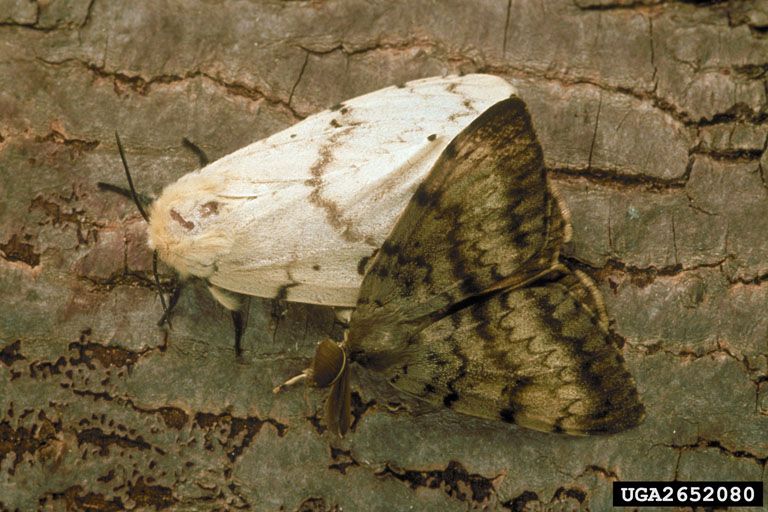
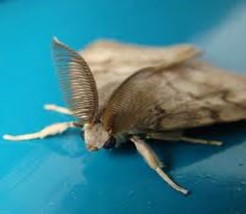
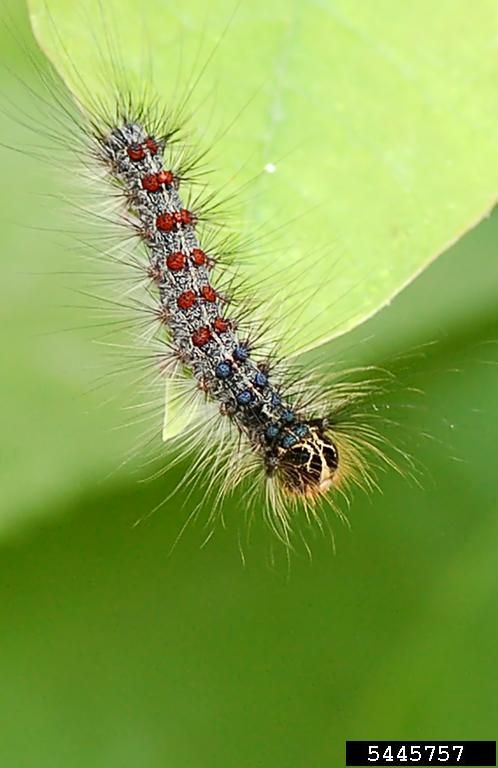
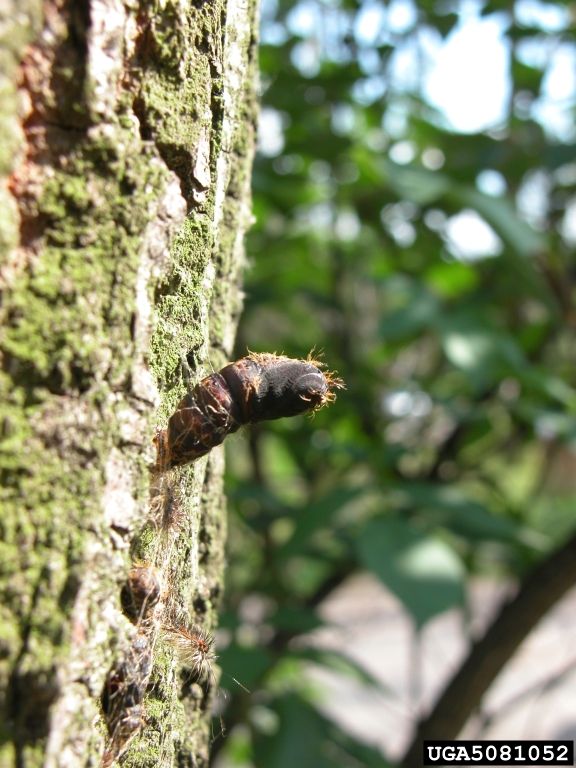
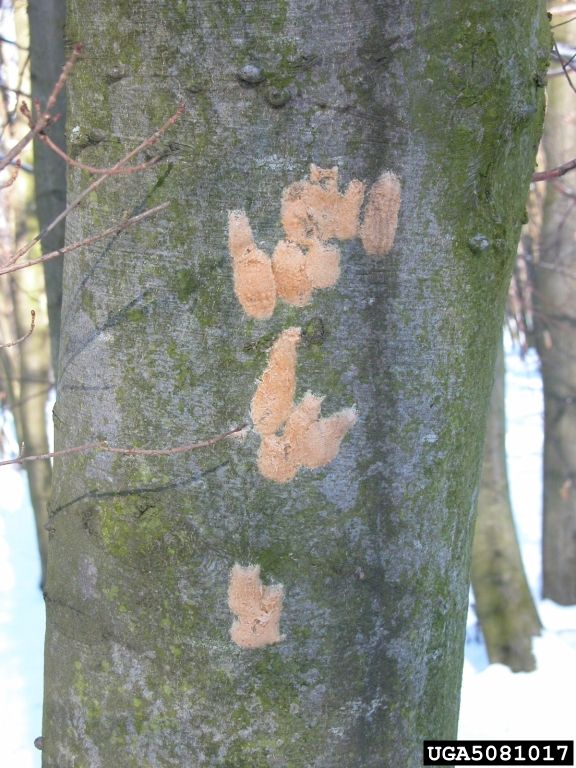
What should I do?
- Report immediately
- Share your photos with us using the Online Public Reporting Form OR
- Call the Exotic Plant Pest Hotline 1800 084 881.
- Please take good quality photos of the pest and/or damage to include in your report. For tips see the How to take good quality photos for a report guide.
Why is it a pest of concern?
- Spongy moth caterpillars feed on more than 600 species of broadleaved trees in the agricultural, horticulture and forestry industries.
- High numbers of feeding caterpillars can completely strip trees of all their leaves (Fig 6).
- Stress associated with feeding damage can result in reductions in tree growth, dieback, susceptibility to secondary attack from other insects and pathogens and ultimately tree death.
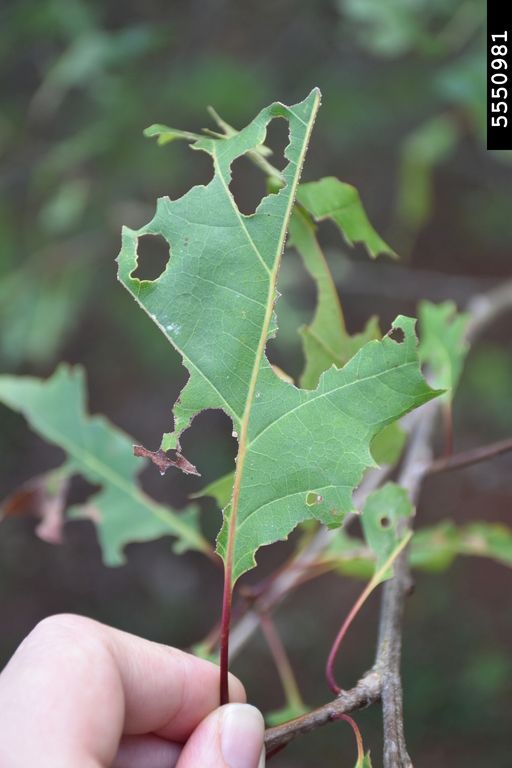
Where to look
- Caterpillar feeding damage on host tree appears initially as holes in the leaves or as irregular leaf margins, but whole leaves may be consumed as larvae mature. Older caterpillars feed largely at night.
- Egg masses can be deposited on any solid object such as tree trunks and branches, rocks, outdoor furniture, machinery, vehicles, buildings, shipping containers and ships (Fig. 6).
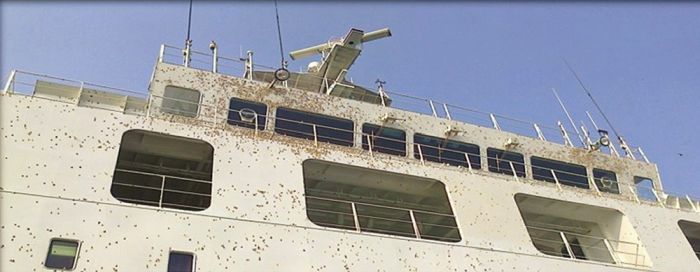
Pest profile
Appearance
- Adults: Female moths are up to 63 mm long. They have cream-coloured wings with distinctive black markings and thread-like antennae. Males are smaller than females, are mottled brown to grey in colour and have distinctive feathery antennae (Fig. 1).
- Caterpillars: Newly hatched caterpillars are very small; 3 mm long. Caterpillars grow up to 90 mm long following a series of growth stages each time shedding their previous skin. Older caterpillars are dark and hairy, with five pairs of blue spots and six pairs of red spots along their back (Fig. 3).
- Pupae: Pupae are dark brown and enclosed in a yellow silken cocoon, attached to trees, branches, rocks, fences and other outdoor structures. (Fig 4).
- Eggs: Spongy moth egg masses are brown to creamy yellow, hairy (Fig 5).
Host plants in Australia
- Spongy moth caterpillars are known to over 600 different types of tree and shrub species including orchard trees, ornamentals and forests.
- The most susceptible trees are alder, apple, aspen and poplars, basswood, birch (a preferred host), cherry, hawthorn, hazelnut, larch, mountain ash, oak (a main host), pears, willow, and witch-hazel.
- The wide host range indicates that many Australian native plant species are likely to be susceptible.
Life cycle
- Spongy moths complete their life cycle in one year.
- Eggs masses are laid in summer. An individual egg mass usually consists of 600-1000 eggs.
- Caterpillars hatch in spring from eggs laid the previous summer. They often remain on the spent egg masses until a warm day arrives, at which time they start their journey in search of foliage.
- Caterpillars go through a series of growth stages each time shedding their previous skin. Males undergo 5 stages while females undergo 6. Each stage lasts approximately 2 weeks depending on the weather.
- When caterpillars are fully grown (around 2 months) they pupate by transforming in a cocoon. This phase last approximately 3 weeks.
- After pupation, the adult moth splits the cocoon to emerge. Males emerge first, several days prior to the females.
- Adults are found in late summer and early autumn. They do not feed and are short-lived, only surviving for a week.
Distribution
There are several subspecies of Lymantria dispar which look similar but differ in their geographical range, behavioural characteristics, and host plant preferences. All subspecies pose a biosecurity threat to Australia.
- Lymantria dispar asiatica – Asian spongy moth - widely distributed throughout Asia from the Ural Mountains and Central Asia in the west to the Far East Russia, China, Korea and Japan.
- Lymantria dispar dispar – North American spongy moth, European spongy moth - is widespread across North America, Europe, and North Africa.
- Lymantria dispar japonica - Japanese spongy moth - found only in Japan.
Dispersal
- Egg masses are easily transported long distances on freight, vehicles, pallets, and shipping containers (Fig. 7).
- Small caterpillars can balloon (spin silk that catches the wind) which allows them to disperse up to several kilometres. (Fig. 8).
- Adult females are strong flyers and can long distance dispersal by being carried on wind currents.
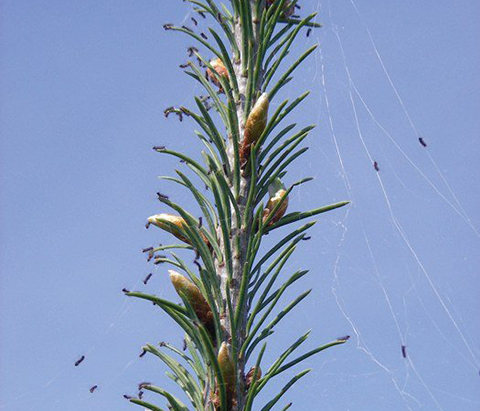
Image credits
- Figure 1. US Dept of Agriculture, Animal and Plant Health Inspection Service, Plant Protection and Quarantine, Bugwood
- Figure 2. Agriculture Victoria
- Figure 3. Jon Yuschock, Bugwood
- Figures 4 & 5. Ferenc Lakatos, Bugwood
- Figure 6. Karla Sap.
- Figure 7. Mastro et al (2021) Journal of Integrated Pest Management, 12(1): 31, 1-10.
- Figure 8. Brian Schildt, Pennsylvania Dept of Agriculture, Bugwood
Page last updated: 10 Feb 2025